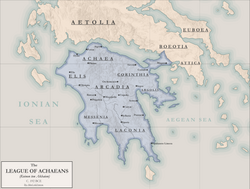League of the Achaeans Κοινὸν τῶν Ἀχαιῶν Koinon ton Achaion | |||||||||||
|---|---|---|---|---|---|---|---|---|---|---|---|
| 280 BC–146 BC | |||||||||||
 Achaean League in 192 BC | |||||||||||
| Capital | Aigion (meeting place) | ||||||||||
| Common languages | Achaean Doric Koine, Koine Greek | ||||||||||
| Religion | Ancient Greek religion | ||||||||||
| Government | Republican Confederacy | ||||||||||
| Strategos | |||||||||||
| Legislature | Achaean assembly | ||||||||||
| Historical era | Classical Antiquity | ||||||||||
• Re-founded | 280 BC | ||||||||||
• Conquered by the Roman Republic in the Achaean War | 146 BC | ||||||||||
| Currency | Drachma | ||||||||||
| |||||||||||
| Today part of | Greece | ||||||||||

The Achaean League (Ancient Greek: Κοινὸν τῶν Ἀχαιῶν, romanized: Koinon ton Akhaion, lit. 'League of Achaeans') was a Hellenistic-era confederation of Greek city-states on the northern and central Peloponnese. The league was named after the region of Achaea in the northwestern Peloponnese, which formed its original core. The first league was formed in the fifth century BC. The second Achaean League was established in 280 BC. As a rival of Antigonid Macedon and an ally of the Roman Republic, the league played a major role in the expansion of Rome into Greece. This process eventually led to the League's conquest and dissolution by the Romans in 146 BC.
The League represents the most successful attempt by the Greek city-states to develop a form of federalism, which balanced the need for collective action with the desire for local autonomy. Through the writings of the Achaean statesman Polybius, this structure has had an influence on the constitution of the United States and other modern federal states.[1]
- ^ Walbank, Frank W. “Polybius and the Roman State.” Greek, Roman, and Byzantine Studies 5 (1964): 239–60.
